The cable is set to have another turbulent week ahead. Protracted Brexit woes continue to exacerbate the underlying volatility currently affecting the British pound, as trade negotiations between the UK and the EU have reached a new impasse. Boris Johnson, who is playing a hard-line role opposite Angela Merkel and Emmanuel Macron, has until this Friday (15th of October) to decide whether to break off the talks with his European counterparts.
It is in the best interest of both parties for a solution to the impasse to be reached before the deadline, which is why the market has mostly disregarded the possibility of a no-deal conclusion. If London and Brussels manage to find common ground before Friday, the value of the GBPUSD is likely to be affected by the manner in which the market discounts the agreement – it boils down to which party would eventually crack under pressure. Therefore, the pair could experience heightened volatility outbursts in the following days, as the market prices in every development concerning the talks.
Meanwhile, the dollar's retreat has been momentarily suspended as the Presidential race in the US continues to bolster the underlying uncertainty. The appeal of the greenback at present stems from investors' heightened demand for havens, to hedge against the unpredictability of the race.
As regards the underlying economic factors that are currently affecting the pair, crucial retail sales data in the US and employment numbers in the UK could further weaken the pound and strengthen the greenback. The consensus forecasts project slightly improved retail data from a month prior in the US, and marginally increased unemployment in the UK.
All of these parallel factors are likely to exert additional pressure on the GBPUSD, which, in turn, would increase the underlying volatility that is currently affecting the pair's price action.
1. Long-Term Outlook:
As can be seen on the daily chart below, there is a divergence between the aforementioned fundamentals and the underlying technicals. The long-term outlook of the price action continues to be prevailingly bullish; however, the strengthening of the dollar and weakening of the pound in the near term could create a new bearish correction.
The price action is currently in the process of establishing a major 1-5 impulse wave pattern, as postulated by the Elliott Wave Theory. Upon reaching a dip at point 4 (in green), which coincided with the 100-day MA (in blue) and the lower boundary of the ascending channel, the price rebounded from the major support level at 1.27600. This latest upswing signals that the price is ready to continue rising further north, with the end goal being the establishment of the final impulse leg (4-5).
However, due to the aforementioned reasons, the price could instead consolidate in a tight range between the major support at 1.27600 and the major resistance at 1.30500. The 50-day MA (in green) represents an additional floating resistance, which substantiates these projections. Accordingly, the 20-day MA (in red) serves as a floating support.
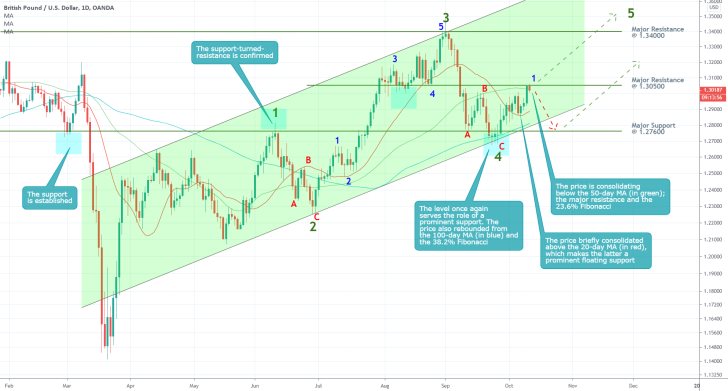
An eventual breakout above the resistance at 1.30500, which has psychological significance as well, would represent a definite confirmation of the bullish sentiment. In the meantime, however, the expected bearish correction could sink as low as the major support at 1.27600 before a reversal occurs. At any rate, a dip could be reached sooner – the 20-day MA and the channel's lower boundary being potential contenders for turning points.
2. Short-Term Outlook:
The recent upswing peaked at the consolidation area, which spans between the psychological level at 1.30000 and the major resistance at 1.30500. The significance of this area as a potential turning point affirms the expectations for a minor bearish pullback.
The price action is likely to consolidate in a range below the resistance in the immediate future. Additionally, there is a high probability for the emergence of false breakouts above set resistance, so the bulls should be aware of such erratic fluctuations.
The behaviour of the price action around the ascending trend line would be of particular interest, as it would likely elucidate the scope of the bearish correction. A tight consolidation around it would entail probable trend-continuation in the immediate future, whereas a decisive breakdown below it could underpin the emergence of a more sizable bearish correction.
For the time being, the underlying momentum continues to be prevailingly bullish; however, its strength appears to be waning. A potential divergence in the near future would imply that the bulls no longer retain control in the market, and the expectations for a more sizable bearish correction would be further justified.
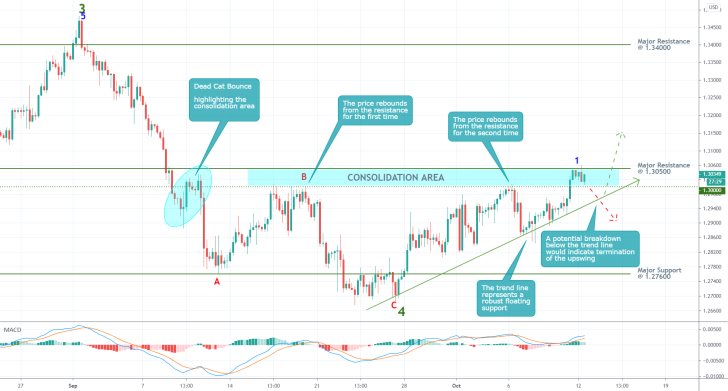
As regards the potential scope and breadth of the expected bearish correction, there are three likely scenarios. Firstly, the price action could remain concentrated within the consolidation area, in which case the dip of the correction should reach the 1.30000 psychological support. This is substantiated by the fact that the level had previously served the role of a major resistance level. Traders should look for potential entries only on the condition that the price action remains trading above the 50-day MA (in green).
Secondly, the price action could sink to the ascending trend line by the end of the week, which seems like the most plausible scenario. The trend line itself outlines the lower border of the correction area. Traders should look for signs of regained bullish momentum similar to the previous times the price action was threading close to the trend line.
Thirdly, the price action could break down below the ascending trend line and the 100-day MA (in blue), in which case it would enter the Probing Area. If this were to happen, traders would have to reconsider using trend-continuation strategies as the underlying bearish sentiment then would be robust enough to terminate the broader uptrend. The next support can be found at 1.29000, so traders would have to look for signs of reversal there.
Of course, the price action could resume heading north immediately, but that should not be interpreted as a definite signal for placing buying orders above the major resistance at 1.30500. As was mentioned earlier, the emergence of false breakouts is quite plausible, so traders should wait for the opportune moment at the end of the next bearish correction in order to join the bullish market. In light of the aforementioned fundamentals, this could take a while.
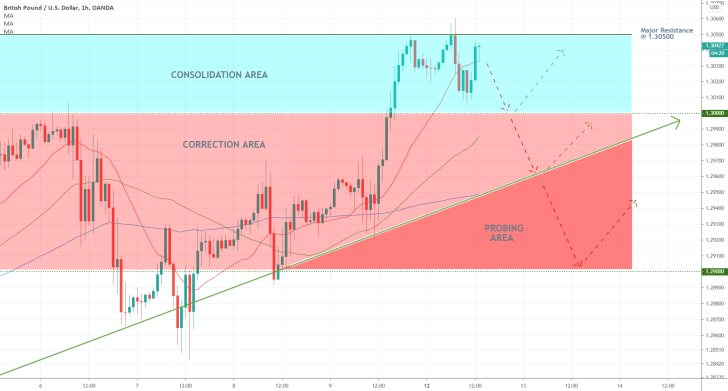
3. Concluding Remarks:
The underlying setup looks most suitable for the implementation of trend-continuation strategies once the market is done developing the next bearish correction. The bulls should be cautious and patient as the current fundamentals are not suitable for the execution of any buying orders at present. It may take several days before the next opportunity to join the existing trend emerges.
The price action unsurprisingly formed a couple of false breakouts above the major resistance level at 1.30500 shortly after the publication of the analysis, as per its projections. Afterwards, the price action started developing the anticipated bearish correction.
The correction itself was initiated after the publication of the latest employment numbers in the UK, which recorded a bigger-than-expected upsurge in headline unemployment over the last quarter. The subsequent release of the September CPI numbers in the US only exacerbated the struggle for the pound, as the greenback received a renewed boost in demand on more coronavirus fears.
Apart from these recent developments, the overall fundamental picture remains pretty much unchanged since the analysis was released, which is why the primary expectations stay the same – looking for favourable entries into the existing bullish trend once the current bearish correction is fully completed. That is why a more detailed examination of the recent behaviour of the price action is needed, in order to examine the potential turning points:
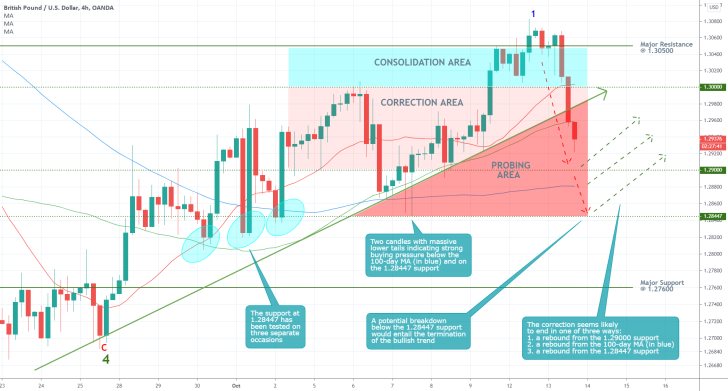
As can be seen on the 4H chart above, the price action recently broke down below the ascending trend line, and entered into the so-called 'Probing Area'. This is the area that we indicated as the testing ground for the bears, and a potential turning point for the correction.
That is why the lower boundary of this triangle – the major support level at 1.28447 – is seen as a crucial threshold. A breakdown below it would signal the likely termination of the broader bullish trend, whereas a reversal anywhere inside the Probing Area would potentially demonstrate the continuation of the uptrend's development. The significance of this support has been confirmed on at least four occasions in the past. In fact, there are two other potential turning points – the 100-day MA (in blue) and the support level at 1.29000.
Traders should be cautious and continue monitoring the situation as it develops. The termination of the current bearish correction at any of the aforementioned levels would likely entail the readiness of the market to continue with the establishment of the broader uptrend, which, in turn, would signal the bulls that they would be ready to implement their trend-continuation strategies.
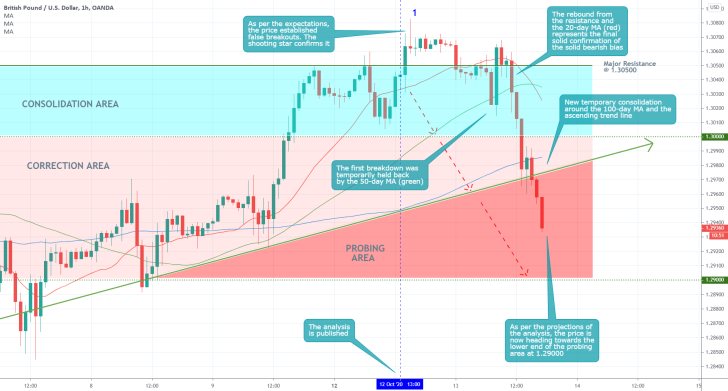
- So far, GBPUSD's price action is behaving exactly as per the projections of yesterday's analysis - shortly after the analysis' publication, the price action established a couple of false breakouts above the major resistance level at 1.30500; afterwards, the anticipated bearish correction started emerging.
- The price broke down below the ascending trend line, which means that there is a high probability that the correction would test the support level at 1.29000. As was already stated in the analysis, do not place any trend-continuation long orders before there are clear indications the correction has been fully completed.
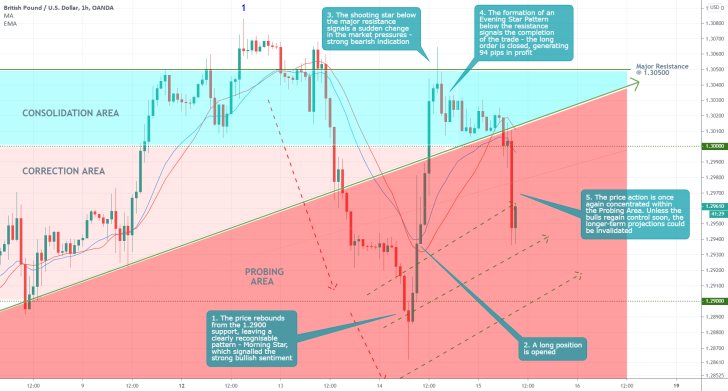
- Excellent overall execution. The price action behaved exactly as per the expectations of the last follow-up. The short-term trade generated 94 pips in profit. The fundamental developments from yesterday catalysed the upswing that was eventually traded. Traders need to remember that when the underlying fundamentals match their technical expectations, there is a heightened probability that the price action would go in their anticipated direction.
- The behaviour of the price action should be monitored in the near future. If it breaks down below the 1.29000 level once again, the longer-term expectations of the analysis might have to be adjusted. That is so because a new breakdown would entail increased bearish sentiment in the short-term.
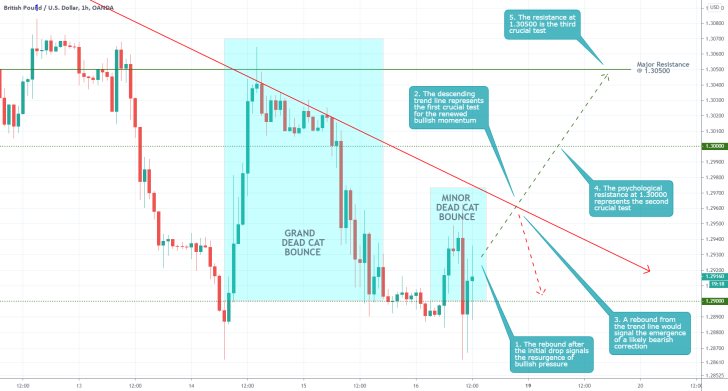
- Following the crucially important Brexit developments from today, a no-deal divorce now seems more than likely. Even still, the longer-term expectations concerning the bullish trend of the GBPUSD may yet be realised. In particular, the price action looks ready to attempt forming a new upswing one more time. The rebound from the psychologically significant support level at 1.29000 represents the most substantial bullish confirmation.
- If the price action manages to break out above the descending trend line, this will imply even stronger bullish sentiment. However, a rebound from it would mean that the bears retain control. The latter scenario would also underpin the completion of another 'Dead Cat Pattern, which, in turn, could be used by market bears as an indication for entry.
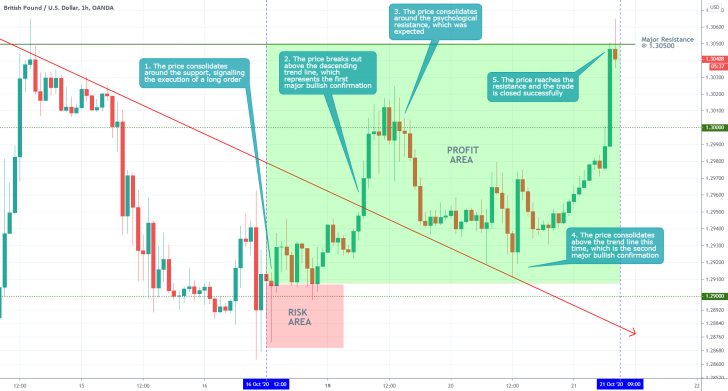
- Since the publication of our previous journal entry concerning the GBPUSD, the pair moved by another 140 pips in the expected direction and hit the suggested target level. With that, the price has moved in total by over 230 pips since the publication of the initial analysis.
- The rebound from the psychologically significant resistance at 1.30000 represented the most substantial challenge for the underlying expectations; however, the subsequent pullback from the descending trend line, which now serves as a support, affirmed the bullish expectations once again. Furthermore, the robust fundamental factors contributed to the realisation of the forecast. With that, the expectations of the initial analysis are now fully realised.
- The biggest takeaway here is to believe in your trades when both the fundamental and technical factors are inlined with each other.
Disclaimer: Your capital is at risk! Trading and investing on the financial markets carries a significant risk of loss. Each material, shown on this website, is provided for educational purposes only. A perfect, 100% accurate method of analysis does not exist. If you make a decision to trade or invest, based on the information from this website, you will be doing it at your own risk. Under no circumstances is Trendsharks responsible for any capital losses or damages you might suffer, while using the company’s products and services. For more information read our Terms & Conditions and Risk Disclaimer.





















